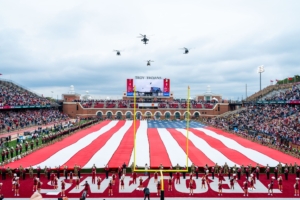Despite having New Year’s Six ramifications, last year’s American Athletic Conference (AAC) Championship Game became almost a TV afterthought. The matchup between Tulane (11-1) and SMU (10-2) drew just 1.88 million viewers and a 1.0 Nielsen rating, meaning that only 1% of televisions nationally watched the Green Wave take on the Mustangs. That viewership tied the 2020 AAC Championship for the lowest in the game’s nine-year history.
This year, the AAC Championship will benefit from a new timeslot on a new day. The PAC-12’s disintegration means their championship game’s traditional Friday night slot on FOX and/or ABC now lays vacant. Thus, ABC was able to put the AAC Championship into that standalone Friday night spot. After years of competing with the SEC Championship, the AAC will now only compete with the Conference USA Championship, which airs on the CBS Sports Network.
Moving to Friday adds to the reputation of the AAC. This primetime network TV slot cements the American as the gold standard among the Group of Five. Other Group of Five leagues have long clamored for the success of the AAC, with the conference claiming seven straight New Year’s Six bids from 2016-2023. Now the AAC Championship will gain a leg-up as well, going front and center for the whole country to see on a massive scale.
To say the least, the move to Friday night should improve ratings. The PAC-12 Championship consistently doubled the viewership of the AAC Title Game. The ten Friday night PAC-12 Championship Games drew an average of 5.43 million viewers and a rating of 3.2, compared to the AAC Championship’s averages of 2.67 million viewers and 1.7 rating. Moreover, several PAC-12 championship games drew substantial viewership without the league’s brand names, USC, UCLA, Oregon, and Washington participating. That Friday night slot is simply a better place for a college football championship game, all other factors aside.
| PAC-12 Championship Friday Night Viewership | ||
| Year | Nielsen Rating (% of Televisions Watching) | Viewers (in millions) |
| 2011 | 2.9 | 4.448 |
| 2012 | 3.0 | 4.9 |
| 2014 | 3.7 | 6.0 |
| 2016 | 3.4 | 5.671 |
| 2018 | 2.6 | 4.059 |
| 2019 | 3.6 | 5.86 |
| 2020 | 2.25 | 3.85 |
| 2021 | 2.5 | 4.247 |
| 2022 | 3.3 | 5.97 |
| 2023 | 4.9 | 9.25 |
| Average | 3.2 | 5.43 |
| AAC Championship TV Ratings | ||
| 2015 | 1.8 | 2.45 |
| 2016 | 1.4 | 2.05 |
| 2017 | 2.3 | 3.385 |
| 2018 | 2.1 | 3.321 |
| 2019 | 1.9 | 2.88 |
| 2020 | 1.15 | 1.88 |
| 2021 | 2.0 | 3.415 |
| 2022 | 1.5 | 2.7 |
| 2023 | 1.0 | 1.88 |
| Average | 1.7 | 2.67 |
***Viewership numbers provided by SportsMediaWatch.com
Two programs could potentially benefit more from this move than the rest of the conference — Army and Navy. Should Army and Navy make the AAC Championship Game, they will have back-to-back network TV appearances against limited competition. Many Power Five schools do not get this kind of exposure. Friends, a potential Army-Navy AAC Championship Game would skyrocket ratings. This increased exposure would then provide a significant recruiting advantage for Army and Navy over archrival Air Force and for the AAC generally against its Group of Five competition.

Hardly anything good in the college football world came from the PAC-12’s downfall. However, strangely, the AAC ends up a winner after the death of that venerable conference. The move to Friday night reaffirms the AAC as the leader of the Group of Five, while Army and Navy have an opportunity to regain some national prominence if they can perform within the conference.











